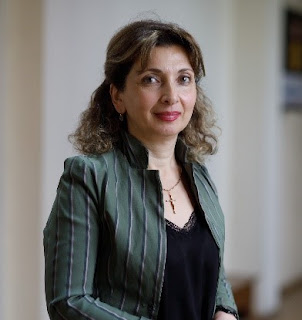მედიცინა და ხელოვნება / Medicine and Art
 |
| მაკა ზარნაძე / Maka Zarnadze მიკრობიოლოგიის დეპარტამენტი, ასოცირებული პროფესორი / Associate Professor, Department of Microbiology |
რა აკავშირებს ერთმანეთთან მედიცინას და ხელოვნებას? ამ თემაზე არ მიფიქრია იმ დრომდე, ვიდრე ჩემი კოლეგისგან საინტერესო და ცოტა უჩვეულო შემოთავაზება არ მივიღე.
თსა-ს ვიცე რექტორმა კვლევის მიმართულებით, ეკა კლდიაშვილმა, მე და ჩემს კოლეგებს შემოგვთავაზა მონაწილეობა მიგვეღო შოთა რუსთაველის ეროვნული სამეცნიერო ფონდის მიერ გამოცხადებულ საგრანტო კონკურსში. კონკურსი მეცნიერების პოპულარიზაციის მიზნით ტარდებოდა. უჩვეულოდ გვეჩვენა ის თემა, რომელიც საკონკურსოდ უნდა წარგვედგინა - მედიცინა და ხელოვნება. ვინაიდან ჩვენს გუნდს უყვარს ინოვაციები და ექსპერიმენტები, არც ამ გამოწვევას შევუშინდით და დავიწყეთ პროექტზე მუშაობა. პროექტის საკონკურსოდ მომზადება საკმაოდ რთული ჩანდა. მოსაძიებელი და დასამუშავებელი იყო საკმარისი ტექსტუალური და ვიზუალური მასალა. თუმცა, ეკა იმდენად თავდაჯერებული ჩანდა, რომ დავთანხმდით. შემოვიკრიბეთ მოტივირებული პედაგოგები და დავიწყეთ ინფორმაციის მოძიება მედიცინისა და ხელოვნების კორელაციის შესახებ.
შავი ჭირის პანდემიის მსხვერპლთა დაკრძალვა ტურნაში (ბელგია) მინიატურის ფრაგმენტი გილ ლი მუისის მატეანედან (1347-52)
და მართლაც, მუშაობის პროცესში, მედიცინისა და ხელოვნების ურთიერთკავშირის და ურთიერთზეგავლენის უამრავი მაგალითი გავიხსენეთ და მოვიძიეთ, იმაზე გაცილებით მეტი, ვიდრე ველოდით. აღმოვაჩინეთ არაერთი მაგალითი, სადაც კაცობრიობის ისტორიაში არსებული უმძიმესი პანდემიები და ეპიდემიები ხელოვნების ნიმუშებშია ასახული; დაავადებები, რომლებიც ოდითგან აშინებდა კაცობრიობას, ცნობილი მხატვრების შედევრებს შორის არის (მაგ. ედვარდ მუნკის ნამუშევარი - მომაკვდავი ბავშვი, სადაც ტუბერკულოზით დაავადებული მხატვრის და არის გამოსახული). ბევრი ხელოვანი ამით თანაგრძნობას გამოხატავდა სხვადასხვა მძიმე სენით შეპყრობილი ადამიანების მიმართ. მართალია მიკრობები უმძიმეს დაავადებებს იწვევენ, მაგრამ ამავე დროს, თურმე, შესაძლებელია დახატო ბაქტერიებით და შექმნა მიკრობული ხელოვნების ნიმუშები. აღმოჩნდა, რომ ზოგიერთი ხელოვანის წარმატება, სწორედ რომ მისი ანატომიური თავისებურებებით იყო განპირობებული. მაგ. ვიოლინოს ვირტუოზს, ნიკოლო პაგანინის, სახსრების უჩვეულო ელასტიურობა ახასიათებდა.
ბევრი აღარ გვიფიქრია, შევიტანეთ ფონდში განაცხადი და დამამთავრებელი კლასების (X,XI, XII) მოსწავლეებისთვის ლექცია-სემინარების სახით, მედიცინისა და ხელოვნების ურთიერთქმედების შესახებ ინფორმაციის მიწოდება დავიწყეთ. ინფორმაცია უნდა ყოფილიყო სახალისო, თვალსაჩინო და ინტერაქციული.
პროექტის ფარგლებში, მსმენელებს ჩაუტარდათ როგორც ლექცია-სემინარები, ასევე, შესაძლებლობა ჰქონდათ საკუთარი ხელით შეესრულებინათ მარტივი ექსპერიმენტები აკადემიის სასწავლო-კვლევით ლაბორატორიაში. მაგალითად, დაეხატათ ბაქტერიებით, დაეთვალიერებინათ სხვადასხვა ნიმუში მიკროსკოპის ქვეშ და ა.შ.
პროექტის დასკვნით ნაწილში მოსწავლეებმა წარმოადგინეს პრეზენტაციები, რომლებიც ასახავდა მედიცინის კონკრეტული თემებისა და ხელოვნების ინტეგრაციის საკუთარ ხედვას. პროექტი წარმატებული აღმოჩნდა. მისი წარმატება განაპირობა სწორად მოწოდებულმა იდეამ, აკადემიის ლექტორებმა და, რა თქმა უნდა, მოტივირებულმა მსმენელებმა. პროექტი ამჟამად გრძელდება. თუმცა, ოდნავ განსხვავებული ფორმატით და სათაურით - “მედიცინა, ხელოვნებაში ასახული ისტორია”. პროექტი მნიშვნელოვანია იმდენად, რამდენადაც მედიცინის და ხელოვნების ურთიერთგავლენით, ახალი ცოდნა და შემოქმედებითი აზროვნება იბადება, რაც მოსწავლეებში მეცნიერების პოპულარიზაციას უწყობს ხელს.
What is the link between Medicine and Art? I have not thought about this topic until I received an interesting and a bit strange offer from my colleague.
Eka Kldiashvili, Vice-Rector in Research at TMA, offered to my colleagues and me to participate in a grant contest announced by the Shota Rustaveli National Science Foundation. The contest was aimed at science popularization.
It felt a bit strange that we had to present the topic- Medicine and Art, in the contest. Since our team loves innovation and experimentation, we were not afraid of this challenge either and started working on the project. Preparing the project for the contest seemed quite difficult, there was enough textual and visual material to be found and processed. However, Eka looked so confident that we agreed. We gathered motivated lecturers and started looking for information about the correlation between medicine and art.

The Citizens of Tournai, Belgium, Burying the Dead During the Black Death of 1347-52. Detail of a miniature from The Chronicles of Gilles Li Muisis (1272-1352), abbot of the monastery of St. Martin of the Righteous
And indeed, in the process of working, we have recalled and found numerous examples of the interconnectedness and interaction of medicine and art, far more than we expected. We have found numerous examples where the worst pandemics and epidemics in human history are reflected in works of art; diseases that have long frightened the human race are among the masterpieces of famous artists (e.g. The work of Edward Munch - a dying child, where the sister of an artist with tuberculosis is depicted), and many artists have thus expressed sympathy for people obsessed with various severe diseases. Microbes indeed cause the most serious diseases, but at the same time it turns out it is possible to paint with bacteria and create microbial artwork. It turned out that the success of some artists was precisely due to its anatomical features, e.g. The violin virtuoso, Niccolo Paganini, was characterized by the unusual elasticity of the joints.
We did not think much about it. We applied for a foundation grant and started disseminating information about the interaction between medicine and art in the form of a lecture seminar for the students of the graduating classes (X, XI, XII). The information needed to be fun, visually attractive and delivered in an interactive manner.
In frames of the project, the participants were offered lecture seminars and had an opportunity to carry out simple experiments with their own hands in the research laboratory of the academy. They could, for example, draw with the bacteria, see different samples under a microscope, etc.
In the final part of the project, the students made presentations that reflected their vision of the integration of specific topics in medicine and art.
The project was successful. Its success was due to a well-delivered idea, academy lecturers, and, of course, motivated students.
The project is continuing to run. However, with a slightly different format and titled - "Medicine – the Story Presented by Art".
The project is important because new knowledge and creative thinking are born through the unification of medicine and art, and interaction, which popularizes science among students.
We successfully use the examples of integration of medicine and art accumulated within the project in various training courses of the Academy's educational program. Such integration of medicine and art, on one hand, makes the teaching process through the interdisciplinary approach more interesting and creative, and on the other hand, promotes the development of critical thinking and empathy within the students, which is very important for future doctors.








Comments
Post a Comment